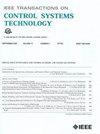Elastic Structure Preserving Control for Flexible Joint Robots With Position-Controlled Actuators
IF 3.9
2区 计算机科学
Q1 AUTOMATION & CONTROL SYSTEMS
引用次数: 0
Abstract
This article presents a novel control approach for flexible joint robots that use servo systems to control their motion. Under this configuration, the servo system is understood to have an inner feedback loop that accepts motor positions as inputs and uses torques as outputs. Hence, the soft robot uses motor positions as control inputs instead of torques. To address this system configuration with a reliable control system of high performance, we aim to generalize the elastic structure preserving (ESP) control approach, which previously has been proposed for backdrivable torque-controlled elastic robots, to robots with position-controlled elastic actuators. This scheme results in a dynamic feedback controller that recovers the elastic structure of the uncontrolled robot in the closed loop. At the same time, damping is injected, thus achieving a control system with high compliance and desired energy dissipation. Our results are supported by a rigorous analysis, where local input-to-state stability and output strict passivity can be concluded if the inner feedback loop from the servo system satisfies some assumptions. Experiments on two platforms validate the proposed control scheme and show the overall control system’s performance.基于位置控制的柔性关节机器人弹性结构保持控制
本文提出了一种利用伺服系统控制柔性关节机器人运动的新型控制方法。在这种配置下,伺服系统被理解为具有内部反馈回路,该回路接受电机位置作为输入,并使用扭矩作为输出。因此,软机器人使用电机位置作为控制输入,而不是扭矩。为了用可靠的高性能控制系统解决这种系统配置问题,我们的目标是将弹性结构保持(ESP)控制方法推广到具有位置控制弹性执行器的机器人,该方法先前已被提出用于反驱动扭矩控制弹性机器人。该方案设计了一个动态反馈控制器,在闭环中恢复不受控制机器人的弹性结构。同时,注入阻尼,从而实现了高顺应性和理想耗能的控制系统。我们的结果得到了严格分析的支持,如果伺服系统的内部反馈回路满足某些假设,则可以得出局部输入-状态稳定性和输出严格无源性。在两个平台上的实验验证了所提出的控制方案,并展示了控制系统的整体性能。
本文章由计算机程序翻译,如有差异,请以英文原文为准。
求助全文
约1分钟内获得全文
求助全文
来源期刊

IEEE Transactions on Control Systems Technology
工程技术-工程:电子与电气
CiteScore
10.70
自引率
2.10%
发文量
218
审稿时长
6.7 months
期刊介绍:
The IEEE Transactions on Control Systems Technology publishes high quality technical papers on technological advances in control engineering. The word technology is from the Greek technologia. The modern meaning is a scientific method to achieve a practical purpose. Control Systems Technology includes all aspects of control engineering needed to implement practical control systems, from analysis and design, through simulation and hardware. A primary purpose of the IEEE Transactions on Control Systems Technology is to have an archival publication which will bridge the gap between theory and practice. Papers are published in the IEEE Transactions on Control System Technology which disclose significant new knowledge, exploratory developments, or practical applications in all aspects of technology needed to implement control systems, from analysis and design through simulation, and hardware.
 求助内容:
求助内容: 应助结果提醒方式:
应助结果提醒方式:


